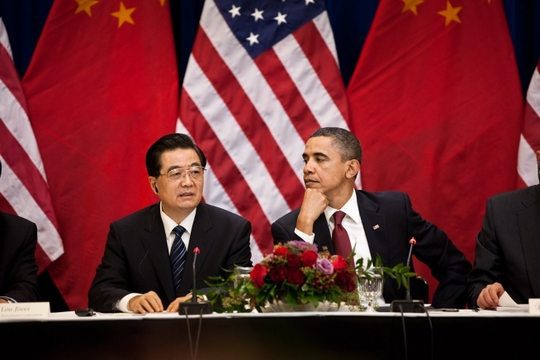There is a trade war brewing between the United States and China over intellectual property relating to clean technologies – particularly solar power.
Steven Chu, a scientist, Nobel Laureate in Physics, and Secretary of the United States Department of Energy, commented: “When it comes to the clean energy race, America faces a simple choice: compete or accept defeat”.
The United States and China have a volatile relationship when it comes to intellectual property and climate change. They vacillate between cooperation, mistrust, and outright conflict.
The rivalry between the United States and China will have important implications for energy security, climate change, and trade in the global economy.
Co-operating and collaborating on clean energy
There has been scientific co-operation and collaboration between the United States and China in some areas of clean technology.
Notably, the US and China signed a Memorandum of Understanding to Enhance Cooperation on Climate Change, Energy and the Environment 2009. The agreement recognised that “co-operation between the United States and China is critical to enhancing energy security, combating climate change, and protecting the environment and natural resources”.

The US-China Clean Energy Research Center (CERC) is facilitating joint research and development of clean energy technologies by United States and Chinese researchers, focussing on:
- technologies for clean vehicles
- carbon capture and storage
- energy-efficient building technologies.
In September 2011, the US and China reached an agreement on managing the ownership and exploitation of intellectual property developed by the Center.
When the friendship breaks down
However, there has also been much rivalry and competition between the two nations on other clean technologies – such as solar panels and wind turbines.
While the United States has a comparative advantage in patent holdings in clean technologies, China has quickly a gained market advantage in the manufacturing of solar technologies.
Kevin Bullis observes: “Today Chinese manufacturers make about 50 million solar panels a year — over half the world’s supply in 2010 — and include four of the world’s top five solar-panel manufacturers”.
There has been increasing patent conflict as the United States competes with China to own the more important clean technologies.

Westinghouse Solar Inc. filed for patent infringement against Chinese solar-panel maker Canadian Solar Inc., and Zep Solar Inc. in the United States International Trade Commission. In response, Zhang Hanbing, senior global marketing director with Canadian Solar, maintained that such claims were groundless.
There has also been disquiet about the acquisition of intellectual property rights from United States companies, bankrupted in the global financial crisis. The United States Department of Energy has expressed its intention to “prevent foreign entities from gaining control over federally funded technology and competing with American industry unfairly”.
The department is trying to block the sale of solar patents from the bankrupt Massachusetts solar panel company, Evergreen Solar, to Chinese purchasers. They are also concerned about who will acquire the patent portfolio of collapsed Californian solar company, Solyndra.
And there have been conflicts over the ownership of wind power. American Superconductor Corp, which makes wind turbine components and transmission grid systems, has sued Chinese wind turbine maker Sinovel Wind Group Co Ltd for US$1.2 billion in China for the theft of trade secrets and breach of contract.
Climate wars
There has been much bickering at an international level between the United States and China over standards of intellectual property protection in relation to clean technologies.
At international climate summits in Copenhagen, Cancun, and Durban, China has promoted intellectual property flexibilities – such as the use of technology transfer, patent pools, public sector licensing, compulsory licensing, and patent exclusions.

In response, United States industry and trade representatives have promoted strong protection of intellectual property rights in clean technologies.
Representative Marsha Blackburn, a Republican from the 7th District of Tennessee, feared that any concessions “would lead to outright theft of our American intellectual property and indirectly benefit the world’s most prominent CO₂ emitters”.
Heading for a trade war?
There have already been trade skirmishes between the two nations.
In June 2011, China ended certain wind power equipment subsidies, after complaints by the United States Trade Representative.
In October 2011, United States Trade Representative Ron Kirk complained to the World Trade Organization about China’s clean energy subsidies. He observed that China had failed to notify the trade body of nearly 200 subsidy programmes, including Chinese policies and practices that affected trade and investment in green technologies.
The Chinese Chamber of Commerce for the Import and Export of Machinery and Electronic Products feared that any trade dispute would “unavoidably cause serious impairment to the sustainable development of the green industries as well as consumers’ interests in both China and the US”.
Some United States solar companies have pleaded for the US President to show restraint: “We believe that you and Vice President Xi have a unique opportunity to avoid such a trade war and find agreement that benefits the solar industries in both countries.”
In his 2012 State of the Union address, though, Barack Obama complained that “it’s not fair when foreign manufacturers have a leg up on ours only because they’re heavily subsidized”.
Steven Chu has observed: “America faces a choice today: are we going to recognise the opportunity and compete in the clean energy race or will we wave the white flag and watch all of these jobs go to China, Korea, Germany and other countries?”
Such tensions indicate there could well be a trade war between the United States and China over the ownership of intellectual property and clean technologies.
Such a battle will have important implications for energy security, climate change, sustainable development, and the global economy.
Matthew Rimmer is an ARC Future Fellow and Associate Professor in Intellectual Property at Australian National University
This article was originally published on The Conversation – theconversation.edu.au. Reproduced with permission.







